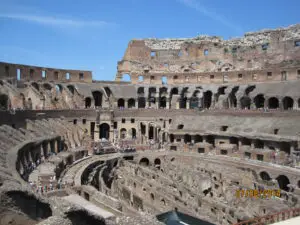Hoplites, heavily armored militia-men fighting in a phalanx formation dominated warfare during the archaic and classical Greek area. But Hoplites were not only used in the Greek sphere of influence but also in other parts of the Mediterranean. In Italy, both the Etruscans and later the Romans used Hoplites and the phalanx formation.
That alone should give us a good idea of the effectiveness of Hoplites fighting in a phalanx formation. But how high was the mortality rate of these Hoplites when they fought a battle?
Hoplites, heavily armored infantrymen fighting in a phalanx formation dominated Greek warfare during the 5th & 4th century BC. In case of a victory, an average of 5% of the Hoplites died while that number rose to 16% in case of a defeat.
The reason for that discrepancy can be found in the phalanx formation. A battle between two armies of Hoplites meant that both sides would advance against each other in a phalanx. Within that Phalanx, the Hoplites stood shoulder-on-shoulder covering each other with their shields and using their spears (dory) and their swords (Xiphos) to stab at their opponents.
Most Phalanx formations were 8 men deep. That meant that the man in the first battle line had a total of 7 men standing in a line right behind him to take his place if he was killed or severely injured.
While that had its advantages when the battle was either not decided yet or won (a deeper phalanx meant fewer chances for the opposing side to break through) it turned into a problem in case of a defeat.
Let`s assume the own phalanx would break.
In that case, the Hoplites would not stay and fight till the last man standing but would try to flee and escape their victorious enemies. And to be faster the Hoplites would throw away their heavy shields, the Hoplon, that made up a good part of their body protection. So in case of a defeat, the Hoplites in the first battle lines of the Phalanx would throw their heavy shields away, turn around and try to flee.
But remember, a phalanx was usually 8 men deep. If the first 3 lines of battle had realized that the battle was lost and it was a good idea to get out then that realization did not necessarily have reached the men in the rear battle lines of the Phalanx.
So while the men in the first lines were already trying to flee the men in the rear lines of the phalanx might still have pushed forward or at least hadn`t turned around and started fleeing yet. When the first lines of a phalanx started fleeing when they realized the emerging defeat and the men in the rear of the phalanx hadn`t realized that then Chaos occurred. And that chaos made it easy for the victorious Hoplites to attack and kill their vulnerable fleeing enemies.
And even when the fleeing Hoplites had managed to distance themselves from their pursuers (the defeated Hoplites who had thrown their shields away could run much faster than the pursuing Hoplites who still carried their shields) they were not safe yet.
While cavalry was not used extensively by most Greek city-states (at least not until Alexander the Great and his Hetairoi, more on them here) cavalry was still used to pursue fleeing enemies.
The individual Greek or Roman soldier was most vulnerable to pursuing infantry and especially cavalry when he tried to flee after his formation had been broken. That was also the moment when the highest casualties of ancient battles occurred!
That principle is generally true for all ancient and medieval warfare.
If you want to find out more about the casualties of medieval battles then I would like to recommend you my article here. And here you can find out more about the mortality rate of Roman soldiers.
Take care of yourself because you deserve it. You really do.
Until next time
Yours truly
Luke Reitzer
Sources
Johannes Kromayer: Heerwesen und Kriegsführung der Griechen und Römer (München 1963).
Nathan Rosenstein: Rome at War. Farms, Families, and Death in the Middle Republic (Chapel Hill 2004).
